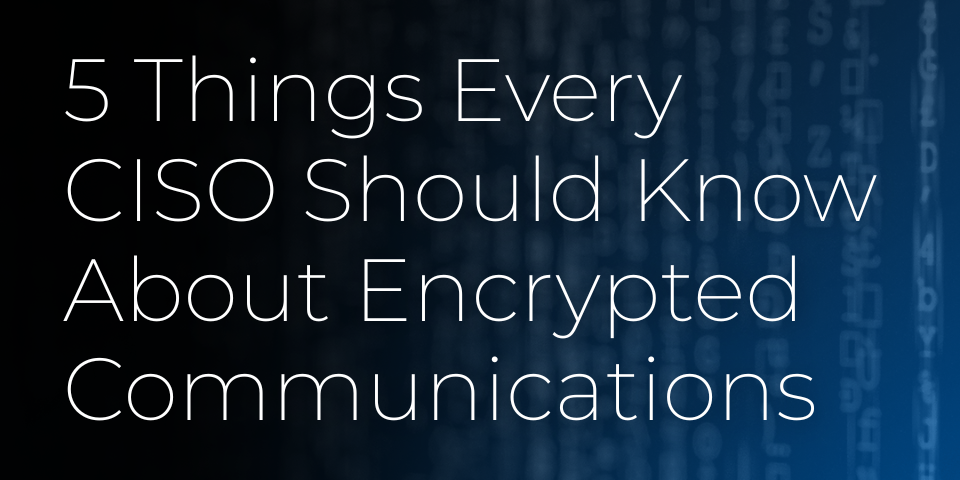
5 Things Every CISO Should Know About End-to-End Encrypted Communications
In today’s threat landscape, end-to-end encrypted communications are no longer a luxury, they’re a necessity. But while many organizations assume that implementing encryption is enough to protect their sensitive information, the reality is far more complex.
Cyber attackers are more sophisticated than ever. From state-sponsored espionage to insider threats and metadata leaks, the communications environment has become a battleground. For Chief Information Security Officers (CISOs), understanding the true scope, and the limitations, of encrypted communications is essential.
Here are five things every CISO must know to build a secure and resilient messaging strategy.
1. Encryption Protects Content – Not Metadata
End-to-end encryption ensures that only the sender and recipient can read the contents of a message. But message metadata, including who is communicating, when, how often, and from where, often remains exposed.
Why it matters:
Adversaries don’t always need access to message content. Metadata alone can reveal sensitive operational patterns or identify high-value targets.
Best practice: Choose a communications solution that not only encrypts messages but also controls or obfuscates metadata exposure at every level.
2. Consumer Messaging Apps Weren’t Built for High-Risk Environments
Apps like Signal and WhatsApp do offer end-to-end encryption, but they’re designed for convenience, not for mission-critical communications in regulated industries or government settings.
- Seamless group creation
- Contact list syncing
- Third-party notifications
These features may boost usability but increase the attack surface and the risk of human error.
Best practice: Adopt secure messaging platforms like KoolSpan’s TrustCall 11, built specifically for high-assurance environments, with hardened architecture and tightly controlled user permissions.
3. Deployment Environments Play a Huge Role in Security
Most consumer-grade apps rely on public infrastructure. For CISOs managing classified, proprietary, or regulated data, that’s a serious risk.
- Public cloud = shared resources, greater exposure
- Private cloud or on-premise deployments = full control
Best practice: Ensure your communications platform can support secure deployment environments, including air-gapped networks and isolated private infrastructure.
4. Controlling User Behaviour Is Just as Important as Technology
The biggest threat to secure communications often comes from the inside. Not from bad actors, but from well-meaning employees making avoidable mistakes.
- Inadvertently adding unauthorized users to a group
- Using personal devices for business-critical communication
- Sharing sensitive info via public messaging apps
Best practice: Use encrypted communications platforms with built-in behaviour controls, like KoolSpan’s Trust Circles, which ensure users can only communicate within defined, authorized groups.
5. A Hardened Backend Makes All the Difference
Even with strong encryption, vulnerabilities in backend systems can expose your organization to threats like:
- SQL injection
- Unauthorized access
- API misuse
TrustCall 11 takes a layered approach to security:
- Decoupled architecture
- Rigorous code testing
- Private notification and messaging services – fully disconnected from the public web
Best practice: Prioritize platforms with zero trust architecture, minimal external dependencies, and military-grade backend hardening.
Why TrustCall 11 Is Built for CISOs Who Can’t Afford to Be Wrong
In an era of escalating threats, “good enough” encrypted communications simply aren’t good enough.
KoolSpan’s TrustCall 11 is designed from the ground up for the highest-stakes environments; defense, intelligence, critical infrastructure, and enterprise sectors that demand absolute control, privacy, and reliability.
With TrustCall 11, your organization gets:
- End-to-end encrypted communications
- Protected metadata
- Private, secure deployment options
- Administrative control over user behaviour
- Hardened architecture built for zero-trust environments
Final Thoughts
For today’s CISOs, encryption is only the starting point. True secure communications require a comprehensive, multi-layered approach, from backend architecture to user access controls.
If you’re responsible for protecting sensitive or classified conversations, it’s time to look beyond consumer apps and embrace a platform built for your level of risk.Want to learn more about KoolSpan’s secure communications solutions?
Contact our team today or explore the full capabilities of TrustCall 11 here.